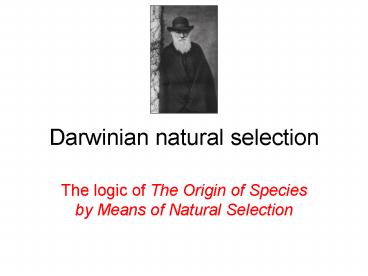Darwinian natural selection - PowerPoint PPT Presentation
1 / 26
Title:
Darwinian natural selection
Description:
Darwinian natural selection The logic of The Origin of Species by Means of Natural Selection Darwin s four postulates 1. Individuals within populations are variable 2. – PowerPoint PPT presentation
Number of Views:144
Avg rating:3.0/5.0
Title: Darwinian natural selection
1
Darwinian natural selection
- The logic of The Origin of Species by Means of
Natural Selection
2
Darwins four postulates
- 1. Individuals within populations are variable
- 2. Some of these variations are passed on to
offspring
variation
heritability
from the Illustrated London News (1851), in
Secord (1981)
3
Darwins four postulates
- 3. In every generation, more offspring are
produced than can survive. Some individuals
survive and reproduce better than others. - Most populations are stable in number over years,
despite great reproductive potential
4
Darwins four postulates
- 4. The individuals that survive and reproduce the
most are those with favorable variations. They
are naturally selected. - Survival and reproduction are not random
- They are linked to the variation among
individuals
5
Darwinian natural selection
- Selection on beak shape in Galápagos (Darwins)
finches
6
There are 15 species of Darwins finches,
derived from the grassquit (genusTiaris) of
mainland Central and South America
This complex of species is closely related but
shows remarkable variation in beak size and shape
7
This great variety of bill characteristics allows
use of a broad spectrum of diets
Cactospiza pallida
8
15 species are on the Galápagos islands off
Ecuador, with one species on Isla Cocos off Costa
Rica
9
The ground finches a phylogenetic group
primarily of fruit and seed eaters The medium
ground finch Geospiza fortis cracks seeds at the
base of its thick bill
10
Peter and Rosemary Grant and colleagues have
tagged 100 of the G. fortis population on
Daphne Major (1200 birds average), and studied
them for gt 30 years
11
Testing postulate 1
- Variation
12
1976 Data
Figure 3.6 Variation in beak depth in G. fortis.
The finches obey Darwins 1st postulate the
population on Daphne Major is highly variable for
beak shape (e.g. depth) and beak size.
13
Testing postulate 2
- Heritability
14
Figure 3.7 Heritability of beak depth in G.
fortis. Peter Boag has shown that variation is
passed to offspring (Darwins Postulate 2).
Tagging allows them to follow parent/offspring
relationships. Offspring beak depth resembles
that of their parents.
15
Testing postulate 3
- Do only a fraction of offspring survive to
reproduce?
16
The Galápagos have wet (Jan - May) and dry
seasons (June -Dec) Extreme drought occurred
during the 1977 wet season (1/5th average
rainfall)
17
The drought led to a severe reduction in the
number of seeds available to G. fortis.
18
During the drought, the usual variety of plants
did not set seed. Tribulus cistoides is an
annual plant whose seeds were the majority
available during the 1977 drought
19
This led to larger and harder seeds available on
average to ground finches. Only large birds with
deep, narrow beaks can crack open and feed on
these harder seeds.
20
Only 16 of the ground finch population survived
the drought to reproduce in later years.
Darwins postulate 3 held truemore offspring
were produced than survived.
21
Testing postulate 4
- Did natural selection occur?
22
Figure 3.9 Beak depth before and after the
drought. Was survival non-random with respect to
beak shape (Darwins postulate 4)? Yesthe
average survivor of the drought had a deeper beak
than pre-1977.
23
This proves that the 1977 drought produced
natural selection for deeper beaks
- But did the population of G. fortis evolve?
24
Evolution is a change, over generations, in the
genetic composition of a population. Evolution
is a response to natural selectiondid this
occur?
To find out, Grant and Grant measured beaks of
the offspring of the survivors.
Offspring beaks had become deeper, proving that
genetic change over generations (evolution) had
occurred.
25
Definitions...
26
(No Transcript)































